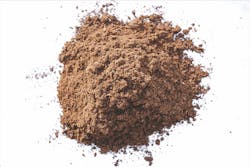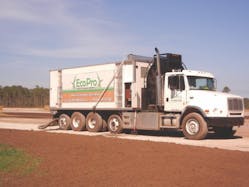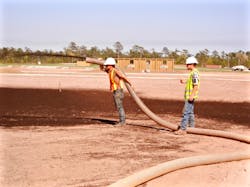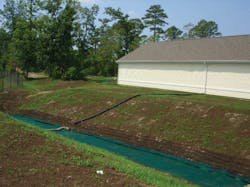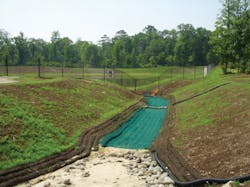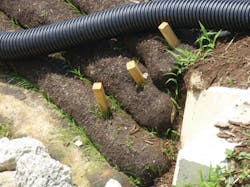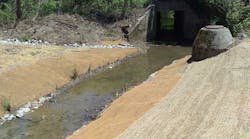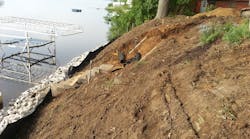When most people think about compost, they picture the stuff gathered in the kitchen, decomposed in the backyard, and then spread on the garden. But compost is more complicated than that, and it offers impressive benefits in stormwater and erosion control applications. Not only does compost capture carbon by diverting waste from landfills, it also holds an immense amount of water, promotes soil health, and can reduce the need for fertilizers. All this from just our kitchen scraps? Well, not quite.
First of all, compost is not what many people think. “A lot of people think that aged mulch is compost,” says Gary Gittere. “It’s really not, it’s an organic residual,” he says. The same goes for kitchen scraps, he says.
For the USCC and the composting industry, kitchen scraps and yard waste don’t cut it; there are certain standards to which compost must adhere.
“You have to have a carbon-to-nitrogen ratio. You need a certain time before it actually decomposes properly—it helps to kill any potential pathogens and things like that,” he explains. “You must have your time and temperature monitored. You have to go through a process to make sure you reduce your pathogens and any vector issues.” Most compost used for stormwater management and erosion control purposes is manufactured, says Gittere.
“If you have two bins, and one says ‘Landfill’ and one says ‘Compostables,’ people just throw things in with the compostables,” he explains. They don’t realize there may be plastic or other non-compostable materials in the waste. Gittere says that the challenge for composting is similar to the “aspirational recycling” problem that plagues the recycling industry—throwing something in the recycling bin because you feel like it ought to be recyclable. Unfortunately, aspirational recycling and composting contaminates waste streams. Gittere says that while industrial composting facilities screen their materials very well, ideally the contamination wouldn’t happen in the first place. “You just need to be cognizant, and it’s [about] education,” he says.
Twenty years ago, the USCC started the Seal of Testing Assurance Program (STA), which analyzes the compost for certain properties including pH, nutrient content, organic matter content, pathogens, and more. Some of the STA standards are for safety and quality; others may address specific problems. On a slope, for example, Gittere recommends a coarser material.
“Compost will hold about 27,000 gallons of water per acre-foot for each one percent of organic matter added to the soil,” Gittere adds. Holding that much water not only address flooding and runoff concerns, but also reduces erosion and helps establish vegetation. “The number one thing for erosion control is establishing vegetation,” he says, “and to have vegetation establishment, you need to have the right soil—the right planting environment.”
During a construction project, for example, soil can be seriously impacted, he explains. Topsoil is often removed, and with that goes all the organic matter and the microbes. The best way to rebuild that subsoil? Compost.
Because compost is about 50% organic matter, it adds microbes back to the soil, which helps establish a good planting environment, he explains.
Most of what is used for erosion control, instead of compost, is straw and tack, Gittere explains. Which, he says, has success if there’s enough soil with enough organic matter and enough rain, but not so much it washes away.
Gittere recalls a highway project he drove past some years ago. The slope was bare until about two-thirds of the way down where vegetation was growing. “Everything had just obviously eroded down to there,” he explains. “What topsoil they had there eroded away, any fertilizer they put on there was eroded away and went into our streams and waterways.”
The phosphorus and nitrogen content of fertilizer have become concerns around the country as water bodies like the Chesapeake Bay and the Gulf of Mexico experience more frequent algae blooms and nutrient-laden fertilizer runoff are blamed. But, Gittere points out, plants need these nutrients and compost can provide them, in addition to other micronutrients.
“I’m not anti-fertilizer,” explains Gittere. “I believe that there’s an application for that. I tell people all the time, that compost is part of the solution. It’s a piece to the puzzle.” Gittere acknowledges that each site is unique, which is why he recommends testing to find out what the site actually needs. In the long run, he says, it will save money.
“Put down the compost, get your seed out, then come back and do a soil test. See what your actual demand really is, because you’re wasting money otherwise,” he advises.
Golf courses are some of the best at this strategy, in Gittere’s experience. “A lot of folks think that golf courses are the biggest waste, but they are the most well-managed of any people we work with,” he says. “They conduct soil analyses, they can only put down so much fertilizer because of cost, and they’re looking for ways of saving, and that’s why the smart ones start to look at using compost.”
Because of compost’s water-holding properties, over the course of two and a half years, one golf course Gittere worked with went from using 1.3 million gallons of water a night to 800,000 gallons. “Now they’re down to 500,000 gallons of water a night because they amended their soil, they got the organic matter built up, they got much better root proliferation, and it allowed them to use much less water.”
“The perception is that it can be expensive, and sometimes it can,” admits Gittere. But, he says, the upfront cost will be offset if compost works better and the work doesn’t have to be fixed later.
Once your soil is healthy, Gittere says you won’t need him anymore. “It’s almost like a bell curve,” he explains. Gittere has done a lot of work in the agriculture industry and after a while, farmers tell him they don’t need to apply as much compost as they did before, or even none. “We tell them, ‘That’s what I told you,’” he says. “You’re going to build your soil back up to the point where it needs to be and after that, you’re all good to go.” He admits that there is some impact you can have on healthy soil—in agriculture, crops are rotated, for example—but by and large, once vegetation can establish, the soil has recovered.
Gittere got into the compost industry, he says, because, “I wanted to get into something sustainable and I wanted it to be green.” He had no experience in the industry (he did once own a garden center that, ironically, didn’t carry compost), but he did have a background in marketing. Now, in addition to his day job for a compost manufacturer, he gives presentations on the general benefits of compost. “I absolutely adore the industry,” he says.
Gittere sees opportunities for compost use everywhere. “Every place where you see dirt, you could have compost,” he jokes. In reality, that would be unrealistic, he says, but there are signs that composting is becoming more common. California, for example, has set a goal that 75% of solid waste be recycled, composted, or reduced by 2020, and in 2014 began requiring business to recycle their organic waste. In Vermont, food scraps will be banned from the trash as of July 1, 2020. Although not all of the organic waste in Vermont or California ends up as compost—some will be used to feed animals, some to create biogas—Gittere sees this as a win. In the landfill, food waste and other organics decompose and produce methane gas, which is both a potent greenhouse gas and a potential energy resource. As waste diversion becomes more common, awareness of the compost industry grows.
“It takes a groundswell of people saying, this is really what we have to do,” says Gittere. “Fortunately, compost is a big part of it.”
